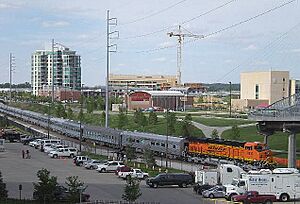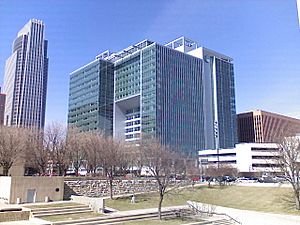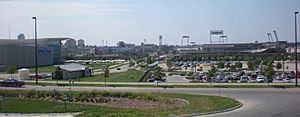Economy of Omaha, Nebraska facts for kids
Omaha, Nebraska, has always been an important business city in the middle of the United States since it started in 1854. It's even called the "telecommunications capital" of the U.S., meaning it's a big center for phones and internet. Omaha's economy includes farming, making food, insurance, transportation, healthcare, and education. Many big companies, like Berkshire Hathaway (led by famous investor Warren Buffett), ConAgra Foods, Union Pacific Railroad, Mutual of Omaha, and Kiewit Corporation, have their homes here. These are all huge companies!
In March 2008, only 3.9 percent of people in Omaha were looking for jobs. Between 2000 and 2005, the number of jobs in Omaha grew by 0.70 percent. In 2006, the average family income was $56,869.
In September 2007, Omaha was ranked eighth among the 50 largest cities in the United States for having the most billionaires and Fortune 500 companies per person. No other city could say the same!

Omaha's Economic Past: How it Grew
After Omaha was founded, its economy grew in waves. Being a major transportation hub helped many different types of businesses start in the downtown area. Early warehouses were right by the Missouri River. This allowed goods to come in by steamboats from cities like Kansas City and St. Louis.
The Union Pacific Railroad has been based in Omaha since it began. This brought big industries like meatpacking, stockyards, and breweries to the city.
Wholesale and Manufacturing: Making and Selling Goods
In 1870, Omaha became a big center for "wholesale jobbing" in the United States. A wholesale jobber bought goods directly from factories. They then used railroads to transport these goods and sold them to smaller businesses. Omaha jobbers sold many different products, including groceries, clothes, hardware, and paper. The city even built a special market house and a warehouse area for food.
Omaha got its nickname, "Gateway to the West," because it was a central transportation spot in the 1800s. Many people traveling west, like settlers and gold seekers, passed through here. This helped the city grow. Warehouses, carriage factories, and barbed wire factories popped up. Downtown stores like Brandeis and hotels like Hotel Fontenelle also grew. The city's breweries, brickyards, iron works, and flour mills made Omaha grow very fast between the 1880s and 1920s.
The main breweries in Omaha back then were Storz, Krug, Willow Springs, and Metz.
Early Businesses in Omaha
Some important early businesses in Omaha included the Western Bridge and Construction Company. Other key companies were the Byron Reed Company and the N.P. Dodge Company.
Stockyards and Meatpacking: A Huge Industry
The meatpacking industry, along with the Omaha Stockyards, started growing in the 1890s. This industry brought a lot of money to the city until the 1970s. Omaha's Stockyards were a big rival to Chicago's and were the third largest in the nation by 1890.
The "Big Four" meatpackers in Omaha were Armour, Wilson, Cudahy, and Swift. By 1947, Omaha was second only to Chicago in worldwide meat production. In 1955, Omaha became the largest livestock market and meatpacking center in the U.S., holding that title until 1971. The stockyards closed in 1999 after 116 years.
Meatpacking Companies
Many meatpacking companies operated in Omaha. Large plants included Armour, Cudahy, Swift, and Morris. Together, these companies employed over 13,000 people by the 1950s.
Transportation: Connecting the Country
The Missouri River was Omaha's first source of income. Fur traders used the area to build their businesses. As steamboats brought goods from the Eastern United States, thousands of tons of products passed through Omaha.
The need to move materials across the growing Midwest led to Omaha's biggest growth period. From about 1865 to the 1880s, Omaha grew because of its railroad connections. Almost all major rail traffic from the Pacific Northwest came through the city. By the 1870s, Omaha had seven major train lines.
Today, major bus lines and airlines have served the city for almost 100 years. Many highways and bridges also lead into Omaha.
Important Business Leaders from the Past
Many early business leaders helped Omaha grow. These included bankers, investors, and lawyers. William D. Brown is said to have founded Omaha. He ran the Lone Tree Ferry, which brought settlers from Council Bluffs, Iowa. Alfred D. Jones was a surveyor and lawyer who first planned out the city.
Later, brothers Edward Creighton and John A. Creighton came from Ohio, setting up telegraph wires. They helped the city a lot with banking, investing, and charity. The Kountze family also had a huge impact. Augustus Kountze and his brother Herman Kountze started the bank that became First National Bank of Omaha. Today, it's one of the largest independent banks in the U.S.
Newspaper editors like Gilbert Hitchcock and Edward Rosewater were also very important. They promoted and shaped the city's economic growth. Early brewers included Frederick Krug, Frederick Metz, and Gottlieb Storz. In the meatpacking industry, Edward Cudahy, Sr. was a key figure.
Omaha's Economy Today: Modern Industries
Today, the service industry makes up about 40 percent of all jobs in Omaha. Other important areas include trade, transportation, utilities, finance, insurance, and real estate. Telecommunications and construction are also big parts of Omaha's economy. The Greater Omaha Economic Development Partnership also sees the defense industry, manufacturing, and information technology as important.
Because the Strategic Air Command and later the U.S. Strategic Command were located here, Omaha has a strong defense industry. The city's transportation is still very important. Over 144 million pounds of cargo passed through Eppley Airfield in 2004. Union Pacific and other major railroads work with trucking companies to move freight around the area.
Studies also show that the Holland Foundation, based in Omaha, is one of the most generous charity groups in the country.
Finance and Insurance: Money Matters
The insurance industry is very important to Omaha's financial health. Omaha is home to the nation's largest privately owned bank, First National Bank of Omaha. It also has Fortune 1000 financial companies like Berkshire Hathaway and Mutual of Omaha. This makes Omaha a city with many financial businesses.
Other insurance companies based in Omaha include Blue Cross Blue Shield of Nebraska, Physicians Mutual, Woodmen of the World, and Berkshire Hathaway companies like National Indemnity Company and Central States Indemnity.
Telecommunications and Information Technology: The Digital Hub
Newsweek magazine once said, "Omaha is where the blue-collar work of the information economy is done. Phones are answered, money is counted, and data are processed. Six national fiber optic networks converge here."
The telecommunications industry has grown a lot in Omaha over the last 30 years. After the U.S. government moved the Strategic Air Command here after World War II, Omaha got one of the most advanced and secure phone systems in the world. Other reasons for its success include being in the Central Time Zone, which makes it easy to call both coasts during the workday. Also, people in Omaha speak with a "pure American" accent, which is easy for everyone to understand.
Local phone companies in Nebraska were allowed to quickly offer new services. Plus, Metropolitan Community College created courses for telecommunications. Since the early 1980s, many large hotel and travel reservation centers, like those for Marriott, Hyatt, Radisson, and Westin hotels, have been in Omaha. The traffic information center for Greyhound Bus Lines is also here.
After the AT&T breakup, US West, the phone company for Nebraska and 13 other states, used the slogan "Dial 800 and get Omaha" to promote its services. The worldwide telecommunications company West Corporation started in Omaha in 1986 and is still based there. Other big companies with call centers in Omaha include PayPal, Cox Communications, and Aflac.
Omaha was one of the first U.S. cities to build a fiber optic network. Over the past 10 years, its strong telecommunications base has led to a growing information technology sector. Today, Omaha has several schools focused on IT and telecommunications. These include the University of Nebraska's Peter Kiewit Institute and programs at Creighton University and Bellevue University.
Major Companies and Employers
The largest employer in the Omaha area is Offutt Air Force Base, with over 10,000 military and civilian workers. The second largest is Alegent Health, with about 7,500 employees. Omaha Public Schools and First Data Corporation each have about 7,000 employees.
Other major employers include Methodist Health System, Mutual of Omaha, ConAgra Foods, Nebraska Health System, Odyssey Staffing Inc., Staff Mid-America, and the West Corporation.
Influential Business Leaders Today
According to USA Today, Omaha ranks eighth among the nation's 50 largest cities for having the most billionaires and Fortune 500 companies per person. Warren Buffett, known as the "Oracle of Omaha," was ranked as one of the richest people in the world in 2017. Another important business person in the area is Cathy Hughes, who owns Radio One.
Retail: Where People Shop
Omaha has three main shopping malls: Westroads Mall, Oak View Mall, and Village Pointe. Village Pointe is an outdoor mall with some fancy national stores like Coach and Apple. Shadow Lake Towne Center is another large outdoor mall in the suburb of Papillion.
One Pacific Place and Regency Court Mall are upscale shopping centers. Borsheim's Fine Jewelry store, which is 62,500 square feet, is in Regency Court Mall. Other major shopping centers include Sorensen Park Plaza, Aksarben Village, Midtown Crossing, and Rockbrook Village.
Near Crossroads Mall, you'll find Nebraska Furniture Mart, which is the largest home furnishings store in North America.
Target opened its first "SuperTarget" store, which is a huge store with groceries and general merchandise, in Omaha in 1995.
While downtown Omaha used to be the main shopping area, most stores are now in Midtown and West Omaha. However, the Old Market District still has many unique local shops and boutiques. New developments like NoDo have brought national stores back downtown, such as Urban Outfitters.
Neighborhoods like Benson, Dundee, and South Omaha also have their own main street shopping areas.
Company Headquarters in Omaha
Omaha is home to four companies on the Fortune 500 list: Berkshire Hathaway, Union Pacific, Peter Kiewit and Sons, Inc., and Mutual of Omaha. Many other big companies also have their headquarters in Omaha. These include The Gallup Organization, Physicians Mutual, Werner Enterprises, and First National Bank of Omaha.
Many large technology companies also have major offices in Omaha, such as First Data, PayPal, and LinkedIn. The city is also home to three of the 30 largest architecture firms in the U.S.: HDR, Inc., DLR Group, Inc., and Leo A. Daly Co.. Other companies based in Omaha include Lozier Corporation, West Corporation, ITI Marketing Services, Omaha Steaks, Pamida, Oriental Trading Company, Valmont Industries, First Comp Insurance, Hayneedle, and Godfather's Pizza.
Omaha's Growth and New Projects
Omaha has seen a lot of economic growth recently. In its downtown area, new buildings like the Omaha World-Herald's Freedom Center, the First National Bank Tower, the CenturyLink Center Omaha, and the Gallup University campus have helped bring new life to the city. There's also a pedestrian bridge connecting Omaha and Council Bluffs, Iowa, across the Missouri River.
The north downtown area is also being redeveloped, especially after a new baseball stadium for the College World Series was announced there.
In West Omaha, areas that were once cornfields have become busy commercial districts and wealthy neighborhoods. A new project called Coventry in the southwest part of the city will include mansions, businesses, and shops. There are also projects to improve North Omaha.
In the Midtown area, Mutual of Omaha is redeveloping an area called Midtown Crossing at Turner Park. This project will have condos, apartments, a hotel, a movie theater, a grocery store, restaurants, and other shops. After updating the public Turner Park, this development hopes to encourage more growth in the area.
Another mixed-use project in Midtown is Aksarben Village, built where the old Ak-Sar-Ben arena used to be. This huge complex includes the University of Nebraska at Omaha's Aksarben Campus with learning centers and dorms. It also has the new headquarters for Blue Cross and Blue Shield of NE, First Data's Omaha offices, a grocery store, restaurants, shops, a hotel, and homes.
In 2009, Omaha released a new plan for downtown's development over the next 30 years. It divides downtown into several unique areas, including the Downtown Center, North Downtown, the Entertainment district, and the Old Market District. The Entertainment district includes the CenturyLink Center Omaha and the Charles Schwab Field Omaha. The plan also predicts 8 new office towers in the next 30 years.
Another good economic fact for Omaha is that it was one of the least affected major U.S. cities during the 2008 economic recession.
Poverty and Economic Challenges
Census data from 2000 showed that over 7,800 families in Douglas County lived below the poverty line. This was about 6.7 percent of all families. In 2007, a director of a group that helps people in poverty said that in Omaha, when people talk about low-income issues, they often think about minority groups. As of October 2007, Omaha had the fifth-highest percentage of low-income African Americans among the country's 42 largest cities.




